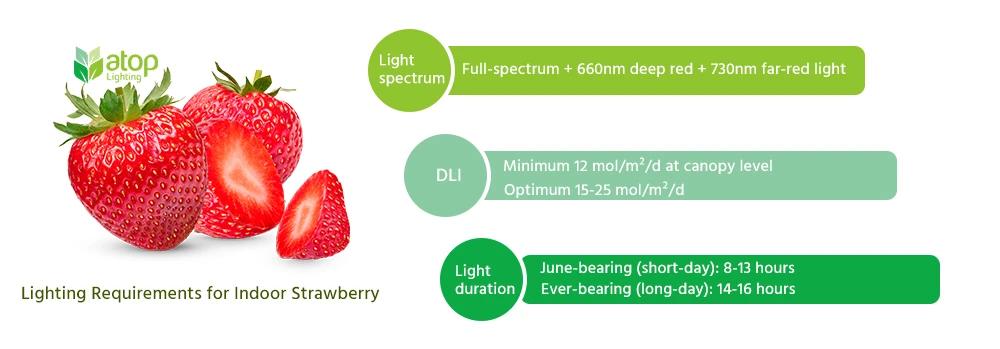Essential Lighting Requirements for Indoor Strawberry
With their vibrant red hue, juicy texture, and sweetness, strawberries have long been a favorite among fruit lovers. But did you know that these delectable berries are now becoming a year-round treat, thanks to innovative indoor cultivation methods?
For growers, off-season strawberry production in greenhouses has become a particularly profitable way. From November through April, when field-grown strawberries are scarce, indoor growers can gain higher prices in the market.
The key to successful indoor strawberry production? Lighting. Artificial illumination, especially LED grow light, plays a crucial role in mimicking the ideal growing conditions these plants need to thrive outside of their natural season. By using supplementary lighting, growers can achieve higher yields and better quality berries, even in the depths of winter.
In this blog, we will share the essential lighting requirements for indoor strawberries to help you achieve higher yields and better quality.

The combination of full spectrum, deep red, and far red allows mimicking natural light
Choosing the right light spectrum is crucial for achieving optimal results in greenhouse cultivation. The primary goal of supplementary lighting is to mimic natural sunlight as closely as possible. Full-spectrum light enhances photosynthesis, maximizing plant growth and development. Additionally, incorporating far-red light can improve flowering and boost overall yield.
At Atop, we've extensively researched various lighting formulas to continually improve growth outcomes. After conducting hundreds of tests, we discovered that a combination of full-spectrum light, 660nm deep red, and 730nm far-red light not only produces the highest yields but also shortens the growth cycle. Our findings show that adding extra far-red light can reduce the flowering period by up to 15%, enabling quicker crop turnover and increased efficiency.

A minimum DLI of 12 mol/m²/d for optimal growth
During winter, natural light intensity might not be sufficient for strawberry cultivation. This is where grow lights become essential. However, achieving the right balance of light for winter strawberry production is a delicate process. Insufficient lighting can result in stunted plants, while excessive light exposure may stress the plants and decrease yields.
The available solar energy varies significantly across different regions during winter. For instance, in the northern United States and Canada, the Daily Light Integral (DLI) – a measure of the total amount of photosynthetically active radiation received over a 24-hour period – can drop to just 5-10 mol/m²/day in mid-winter. Consequently, greenhouse strawberry production in these areas often requires supplemental lighting and CO₂ enrichment.
To ensure optimal growth and productivity, it's crucial to maintain appropriate light levels. While a minimum DLI of 12 mol/m²/d at the canopy level is generally recommended, targeting a DLI between 15-25 mol/m²/d can lead to even better results.
Light duration and temperature impact the flowering of strawberry
Strawberries are fascinating plants with a unique sensitivity to day length, known as photoperiodism. This characteristic plays a crucial role in their flowering patterns. There are two primary types of strawberries: June-bearing and ever-bearing, each with distinct light duration requirements for optimal growth and fruit production.
June-bearing strawberries are classified as short-day plants. They thrive and produce the best yields when exposed to no more than 13 hours of light daily. In contrast, ever-bearing strawberries are long-day plants, flourishing under extended light periods of 14 to 16 hours. This difference in light preferences makes it possible to manipulate strawberry flowering by using artificial lighting to extend daylight hours or by interrupting the night to achieve the desired light duration.
However, it's important to note that the flowering response of strawberries isn't solely dependent on day length. Temperature also plays a significant role in this process. The interplay between temperature and photoperiod can be summarized as follows:
|
Strawberry Tape |
Average Temperature |
|||
|
June-bearing |
<5°C |
5-12°C |
12-26°C |
>26°C |
|
No flower induction |
Flower induction under all photoperiods |
Short day promotes flower induction |
No flower induction |
|
|
Ever-bearing |
<5°C |
5-15°C |
15-30°C |
>30°C |
|
No flower induction |
Flower induction under all photoperiods |
Flowers induction under all photoperiods, but the number of flowers increases under the longer day |
Flower induction is suppressed |
|
Interestingly, when the average temperature drops below approximately 13°C, most short-day strawberry cultivars will initiate flower development regardless of the photoperiod. In these cooler conditions, using artificial lighting to extend the day length won't prevent flowering in short-day strawberries.
Cultivating strawberries indoors? Need expert guidance on horticultural lighting for your grow space? Please feel free to contact us, we will provide the best lighting for indoor strawberries.

